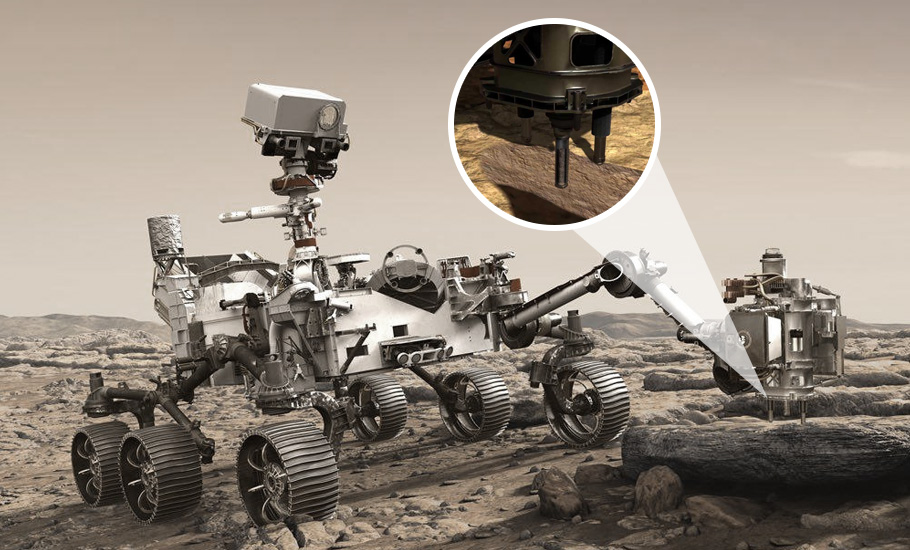
- Home
- News
- Analysis
- States
- Perspective
- Videos
- Education
- Entertainment
- Elections
- World Cup 2023
- Features
- Health
- Business
- Series
- Economy Series
- Earth Day
- Kashmir’s Frozen Turbulence
- India@75
- The legend of Ramjanmabhoomi
- Liberalisation@30
- How to tame a dragon
- Celebrating biodiversity
- Farm Matters
- 50 days of solitude
- Bringing Migrants Home
- Budget 2020
- Jharkhand Votes
- The Federal Investigates
- The Federal Impact
- Vanishing Sand
- Gandhi @ 150
- Andhra Today
- Field report
- Operation Gulmarg
- Pandemic @1 Mn in India
- The Federal Year-End
- The Zero Year
- Premium
- Science
- Brand studio
- Home
- NewsNews
- Analysis
- StatesStates
- PerspectivePerspective
- VideosVideos
- Entertainment
- ElectionsElections
- Sports
- Loading...
Sports - Features
- BusinessBusiness
- Premium
- Loading...
Premium

This is how NASA is bringing back a bit of Mars to Earth
Having performed dry runs on Mars, NASA's Perseverance will now get down to drilling soil samples and returning them to the Earth.

On September 7, 2021, NASA’s Perseverance rover completed the collection of the first sample of Martian rock. The core taken from Jezero Crater is now enclosed in an pencil-thick airtight titanium sample tube, making it available for retrieval in the future. On this occasion, we revisit a story published earlier on how NASA plans to bring back Mars samples to the Earth. For the first 100...
On September 7, 2021, NASA’s Perseverance rover completed the collection of the first sample of Martian rock. The core taken from Jezero Crater is now enclosed in an pencil-thick airtight titanium sample tube, making it available for retrieval in the future. On this occasion, we revisit a story published earlier on how NASA plans to bring back Mars samples to the Earth.
For the first 100 sols (Martian days), NASA’s Perseverance rover was occupied with testing its instruments, sending to Earth pictures and sounds of Mars, performing dry runs and monitoring Ingenuity’s (Mars helicopter) activities.
Now with these preliminary activities in order, Perseverance will get down to tackling its primary agenda of digging up Mars for soil samples.
Over the next two earth years, Perseverance will extensively explore the Jezero crater bed. It will collect rocks and dust samples from Mars to send back to Earth for analysis.
The rover will drill through the surface, scoop up core soil samples, pack them into cigar-sized containers (each holding about 14 grams of the pristine Martian dust), and hermetically seal them. The canisters will be cached around the exploration area. After some time, another rover will go to Mars, collect the canisters from the designated spots and bring them back to Earth.
A long-drawn process
At the outset, the task of collecting and bringing back the samples from Mars appears straightforward. However, there is more than meets the eye.
The exercise involves multiple missions to Mars, complex space manoeuvres, advanced instruments, and cutting edge technologies. So far, interplanetary missions of this magnitude have been an unchartered territory for humans. Several technologies required for the mission are yet to be developed or finalised.
Salty puzzle piece.🧂@NASA has found that organic salts are likely present on Mars & I may be able to detect them. They're the chemical remnants of organic compounds that may provide important clues to the planet’s carbon cycle and potential for past life. https://t.co/EaGHUoGqTi pic.twitter.com/nSZVDhewBY
— Curiosity Rover (@MarsCuriosity) May 20, 2021
To date, Mars missions have been one-way ventures, and none have made round trips. However, now the task at hand involves crucial steps of sending and bringing back the spacecraft. Also, never before have humans fired a rocket from Mars or brought back anything from its surface. Future missions will have to encompass and realise all of the above mentioned critical space procedures.
Envisioning the complexity of the task, NASA began planning for the sample return process four years before launching Perseverance, proposing the Mars Sample Return (MSR) campaign in collaboration with the European Space Agency (ESA).
In December 2020, NASA approved phase A of the sample return campaign detailing the mission requirements, timeframe and the estimate to realise the expedition. The task will entail multiple missions to Mars involving a lander, rover, a mini rocket (launch vehicle) and an orbiter.
Both NASA and ESA would design and build the modules with a preliminary budget of USD 7 billion. The project estimates that the first batch of the soil samples will reach the Earth by 2031.
Here is how the decade-long expedition will unfold.
Collect, pack and toss
After Perseverance digs and collects samples, it will leave the sealed containers on the crater bed at designated spots. Around July 2026, NASA will launch a robotic lander-type spacecraft called the Sample Retrieval Lander.
NASA will build the Lander utilising its decades of expertise in designing and successfully landing similar probes on Mars. The space agency proposes to use the sky-crane method—a combination of a giant parachute and retro motors employed to drop Perseverance—to park the Lander on Mars. The Sample Retrieval Lander will arrive at Mars in 2028 and touch down on the Jezero crater close to Perseverance.
Stop, drill time.🦾
This is my 31st drill hole. They've named it "Bardou." You can spot the .6 inch diameter hole in this image I took using my left Navcam. I'll be studying the mineralogy and chemistry of the sample using my SAM & CheMin instruments. https://t.co/ueNd4ipyj5 pic.twitter.com/KdFgUTONDa
— Curiosity Rover (@MarsCuriosity) April 21, 2021
The Lander will carry ESA’s ‘fetch rover’. This mini rover, the first to be launched by ESA, will do the actual fetching and collecting of the sealed canisters lying around the martian surface. The rover will have a robotic arm to pick up the containers.
The Lander will also house a mini-rocket called the Mars Ascent Vehicle, having a special capsule at its nose-tip that will hold the collected samples. The fetch rover will load the canisters into the rocket’s capsule. The Lander will be programmed to pack and seal the canisters in the capsule to make it suitable for space travel.
The Lander will then fire off the Ascent Vehicle from the surface of Mars. In its second stage, the rocket will release the mini-capsule and hurl it into an orbit around the red planet.
Capture and return
Simultaneously in 2026, around September, ESA will launch a satellite called the Earth Return Orbiter to Mars. This spacecraft will take a shorter route to the red planet and arrive there by 2027—earlier than the Lander. On arriving, the Orbiter will oversee and relay the surface activities of the Lander to Earth and perform all communications of the mission.
The Orbiter will also be the cargo ship for the mission. It will monitor the trajectory of the ejected capsule (containing the samples), intercept it in space and capture it. When they align, a docking port will open to receive the storage capsule. The container will glide smoothly into the porthole.
After this critical space exercise, NASA’s Capture/Containment and Return System payload on the Earth Return Orbiter will take charge of the storage container. Once again, the sample storage container will be repacked into another high-reliability containment capsule to prepare it to survive the descent stage on Earth.
Once the Orbiter returns to the Earth’s orbit, it will release the sealed container into the atmosphere. The container will fall on American soil and will be picked up by NASA.

Why bring back samples? Can they not be analysed on Mars?
Although the sample collection and return are tedious, we presently do not have the technology to set up advanced scientific studies and assess samples on another planet. Moreover, building these facilities is time-consuming and an expensive proposition.
“Bringing Mars samples back to Earth will allow scientists across the world to examine the specimens using sophisticated instruments too large and too complex to send to Mars, and will allow future generations to study them using technology not yet available. Curating the samples on Earth will allow the science community to test new theories and models as they are developed, much as the Apollo samples returned from the Moon have done for decades,” NASA says.
In a press release, Jeff Gramling, Mars Sample Return program director at NASA Headquarters, said, “The scientific advances offered by pristine Martian samples through MSR are unprecedented, and this mission will contribute to NASA’s eventual goal of sending humans to Mars.”
(The author is an independent Science Communicator)

